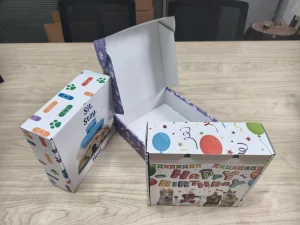Eco-Friendly Packaging: Sustainable Solutions Revolutionizing the Packaging Industry
In a world increasingly conscious of environmental impact, nachhaltige Verpackung has emerged as a pivotal topic in the Verpackungsindustrie. This article explores the evolution of umweltfreundliche Verpackung, offering insights into nachhaltige Verpackungslösungen that not only reduce waste but also meet consumer demands for greener products. Discover how innovative Verpackungsmaterialien and strategies are shaping a more sustainable future.
Inhaltsübersicht
What Is Sustainable Packaging and Why Is It Important?
Nachhaltige Verpackung refers to the development and use of Verpackungslösungen that have minimal environmental impact and footprint. It involves utilizing umweltfreundliche Materialien and designs that promote reusability, recyclabilityund biodegradability.
- Auswirkungen auf die Umwelt: Traditional plastic packaging contributes significantly to pollution and landfill accumulation.
- Verbrauchernachfrage: There’s a growing expectation for brands to adopt sustainable practices and reduce their carbon footprint.
- Einhaltung von Vorschriften: Governments are introducing regulations to minimize Verpackungsmüll and encourage recyclable packaging.
By embracing sustainability in packaging, businesses can not only help the environment but also appeal to eco-conscious consumers.
How Does Traditional Packaging Impact the Environment?
Traditional packaging, often made from non-renewable resources like single-use plastics, has a detrimental effect on our planet.
- Landfill Waste: Packaging waste occupies significant landfill space, taking centuries to decompose.
- Ocean Pollution: Mismanaged waste leads to plastic ending up in oceans, harming marine life.
- Resource Depletion: Producing conventional packaging consumes large amounts of fossil fuels.
The environmental challenges posed by traditional packaging waste underscore the need for sustainable packaging strategies.
What Are Sustainable Packaging Strategies?
Umsetzung von sustainable packaging strategies involves several key approaches:
- Reduce: Minimizing the amount of packaging used without compromising product safety.
- Wiederverwendung: Designing Mehrwegverpackung that can have multiple life cycles.
- Recycle: Utilizing wiederverwertbare Materialien to create recyclable packaging Optionen.
By adopting these strategies, companies can significantly reduce their environmental impact und carbon footprint.

Exploring Eco-Friendly Packaging Materials
The shift towards sustainable packaging materials involves exploring alternatives to traditional plastics.
Biologisch abbaubare Materialien
- Bioplastics: Made from biological substances like corn starch, they decompose naturally.
- Compostable Packaging: Breaks down into non-toxic components within compost facilities.
Renewable Resources
- Mushroom Packaging: Created from agricultural waste and mushroom roots, it’s a erneuerbar und compostable option.
- Bamboo and Hemp: Fast-growing plants used for making eco-friendly packaging supplies.
Recycled Materials
- Recycled Paper and Cardboard: Reduces the need for virgin materials and promotes a circular economy.
- Recycled Plastics: Gives existing plastic a new life, reducing Mülldeponie contribution.
Utilizing these materials supports nachhaltige Verpackung efforts and meets the need for eco-friendly packaging materials.
Reducing Packaging Waste: Recyclable and Biodegradable Options
One effective way to tackle Verpackungsmüll is by opting for materials that can be easily recycled or biodegraded.
Recyclable Options
- Glass and Metal: Infinitely recyclable without loss of quality.
- Certain Plastics: PET and HDPE plastics are widely accepted in recycling programs.
Biodegradable Solutions
- Biodegradable Packaging: Materials like mycelium packaging that decompose naturally.
- Edible Packaging: Innovations where packaging can be safely consumed.
These Verpackungsmöglichkeiten help in reducing waste and minimizing the impact on the environment.

How Can Reusable Packaging Reduce Our Carbon Footprint?
Wiederverwendbare Verpackungen can significantly lower the carbon footprint by:
- Longevity: Extended use reduces the need for constant production of new packaging.
- Resource Efficiency: Less energy and raw materials are required over time.
- Kosteneinsparungen: Long-term use can lead to financial savings for both businesses and consumers.
Transitioning to wiederverwendbar products is a practical sustainable packaging solution that benefits everyone.
Innovative Sustainable Packaging Solutions in the Industry
Die Verpackungsindustrie is witnessing remarkable innovations:
- Mushroom Packaging: Companies are adopting mushroom packaging for its compostable properties.
- Compostable Mailers: Compostable mailers are replacing traditional envelopes in e-commerce.
- Frustration-Free Packaging: Simplified designs that use less material and are easier to open.
These innovations showcase how using sustainable packaging can revolutionize product delivery.
The Role of Bioplastics in Eco-Friendly Packaging
Bioplastics are becoming a cornerstone in umweltfreundliche Verpackung:
- Derived from Plants: Made from renewable resources like corn and sugarcane.
- Reduced Emissions: Lower greenhouse gas emissions during production.
- Compostable: Can be designed to be compostable, reducing landfill use.
Incorporating bioplastics is a forward-thinking approach to Nachhaltigkeit in packaging.
Case Study: Mushroom Packaging as a Renewable Alternative
Mushroom packaging is an innovative solution:
- Natural Growth: Uses mycelium (mushroom roots) and agricultural waste.
- Biodegradable: Fully breaks down without harming the environment.
- Versatile: Can replace foam and plastic in many applications.
This eco-friendly alternative demonstrates the potential of Materialien wie mycelium in creating sustainable products.
How Businesses Can Adopt Sustainable Packaging Practices
Businesses can make a significant impact by:
- Assessing Current Packaging: Understanding the materials you use and their environmental impact.
- Setting Sustainable Goals: Aiming to reduce, reuse, and recycle packaging materials.
- Partnering with Sustainable Suppliers: Working with companies that offer umweltfreundliche Verpackungslösungen.
By adopting sustainable packaging, companies can meet consumer expectations and contribute to a healthier planet.

Conclusion: Embracing Eco-Friendly Packaging for a Sustainable Future
The shift towards nachhaltige Verpackung is not just a trend but a necessity. By exploring and implementing various sustainable packaging strategies, businesses can reduce their environmental impact, meet consumer demand, and pave the way for a greener future.
Wichtigste Erkenntnisse:
- Nachhaltige Verpackung helps reduce the carbon footprint and environmental degradation.
- Utilizing biologisch abbaubar, compostableund wiederverwertbare Materialien is crucial.
- Innovations like mushroom packaging offer exciting alternatives to traditional materials.
- Businesses must assess and adjust their packaging practices to embrace Nachhaltigkeit.
For companies looking to make the switch, consider exploring Individuelle Flip-Top-Boxen mit Magnetverschluss for an elegant and sustainable option, or the versatile Pappschachteln made from recyclable materials. Additionally, Schachteln aus Wellpappe provide sturdy and eco-friendly packaging solutions.
- Sustainability in packaging is essential for environmental preservation.
- Reduce waste by choosing umweltfreundliche Materialien and innovative designs.
- Recycle und Wiederverwendung whenever possible to minimize the ecological footprint.
- Staying informed and adaptable is key to successful nachhaltige Verpackungslösungen.








